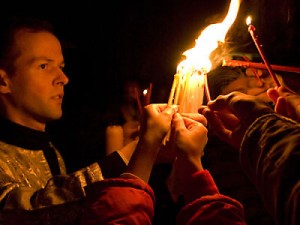 The oldest known non-scriptural Christian hymn is the Phos Hilaron, which was first mentioned in the Apostolic Constitutions (late 3rd-early 4th century) as a hymn to be sung at the lighting of the lamps at evening. St. Basil the Great (d. 379) spoke of the singing of the Phos hilaron as an already established custom. Definitive authorship of this beautiful hymn has not been established, but it is sometimes attributed to St. Athenogenes, an elderly bishop martyred under Diocletian, who is said to have sung it on his way to martyrdom and to have given a written copy to his disciples. The Phos Hilaron may have been written to accompany a ceremony of the Church in Jerusalem. A perpetually burning candle was kept at the tomb of Christ and it was brought out of the tomb at evening as a sign of Christ’s Resurrection.
The oldest known non-scriptural Christian hymn is the Phos Hilaron, which was first mentioned in the Apostolic Constitutions (late 3rd-early 4th century) as a hymn to be sung at the lighting of the lamps at evening. St. Basil the Great (d. 379) spoke of the singing of the Phos hilaron as an already established custom. Definitive authorship of this beautiful hymn has not been established, but it is sometimes attributed to St. Athenogenes, an elderly bishop martyred under Diocletian, who is said to have sung it on his way to martyrdom and to have given a written copy to his disciples. The Phos Hilaron may have been written to accompany a ceremony of the Church in Jerusalem. A perpetually burning candle was kept at the tomb of Christ and it was brought out of the tomb at evening as a sign of Christ’s Resurrection.
The Phos Hilaron has been a set part of the service of Vespers in the Eastern Rite throughout the centuries and has also been used in the services of Roman Catholic, Anglican and Lutheran churches. English translations were made by John Keble, Henry Wadsworth Longfellow, and Robert Bridges. Many composers have been inspired to set the words of the Phos Hilaron to music, and at St. Gregory’s, we make use of several translations and musical settings at our Vespers services. The St. Ambrose Hymnal provides two versions: “Hail, Gladdening Light” (translation by John Keble, music by John Stainer) and “O Gladsome Light” (translation by Robert Bridges, music by Claude Goudimel). As the Christians in Jerusalem did, we sing this hymn in joyful thanksgiving for Christ who is the Light of the world.